Get Updated Every Time New Insights Are Available. Subscribe Today!
This comprehensive post is designed to inspire you to shift from blindly Seeking Value to consciously Serving Your Values.
Picture driving a car.
You consider the car in question to be reliable because it has always gotten you where you need to go. The challenge is, you’ve never had to go that far, nor have you had to get there very fast. The community you live in has everything you need, just a short distance away.
One day, you need to venture outside your community. To get where you’re going you need to take a highway. As you start to pick up speed, you feel the car beginning to shake. It has an alignment issue, one that went undetected for years because you never drove the car fast enough for it to be noticeable. You need to go even faster to keep up with the pace of the traffic on the highway and each time you pick up speed, the car starts to shake even more. Soon it feels like the whole thing is going to shake apart, leaving you stranded on the side of the road.
The car in question is your company’s culture. Culture is defined as the values and beliefs that separate one group of people from another. In most small companies, culture is rarely tested, allowing issues to go undetected. You don’t have enough employees, clients or problems to create situations where your values and beliefs get called into question.
Decide to grow your company however, and it is forced to pick up speed. Being the first to land a client, innovate on a product or hire a key employee now becomes a critical measure of success. ‘Keeping up with the pace of traffic’ becomes a daily challenge. Often this is when companies feel like they are about to shake apart, leaving their leaders and founders stranded on the side of the road. As with the car, this is an issue of alignment. Your people are misaligned with the values of your organization. When tested, they are put in a position where their self-interest is pitted against the interests of the organization, and a conflict emerges. The impact is felt when you have too many people moving in too many opposing directions, attempting to satisfy too many opposing desires.
Given that the human brain prioritizes instant gratification over long term goals, if the self-interest of the person is not aligned with the interest of the organization, the problem will grow worse the faster you go, the more people you add and the further you travel from that small company you once were.
There is however a solution. It is based on the science of social identity theory. This post will detail that solution. We will cover why becoming a values-led organization matters, why you may have struggled to become one in the past, what you need to know to begin to create alignment, as well as the elements of human nature that may conspire to thwart your efforts.
Whether you are currently the owner of a ‘commuter company’ that's pondering growth, or the leader of an organization who's too far into the journey of growth to turn back, this post will offer a practical way for you to rally people to your cause and grow your enterprise without much of the angst you may be feeling now.
Let's start with some simple numbers:
- 85% of purpose-driven, values-led organizations experience annual revenue growth while 42% of companies not consciously led by values suffer annual revenue decline.
- A global study across 30 countries, polling 9,500 leaders found that 81% of companies have some form of Corporate Values Statement even though only 37% of their leaders agreed their values were effective.
- Less than 27% of employees believe in their company's values.
-This lack of values alignment shows up in the fact that 85% of employees are disengaged globally.
These stats offer a compelling reason to take values seriously. Like all stats however, they are easy to dismiss as being vague or not applicable to your specific situation.
So let’s discuss a situation everyone can relate to, trying to motivate a disengaged employee, in order to see how and why values matter so much.
An enigma is defined as something that is mysterious, puzzling or difficult to understand. If you have ever tried to motivate a disengaged employee, we think you would agree that this definition fits that situation.
The good news is we can demystify this issue and make it easy to understand. All you need to know are “The Four C’s": Capacity, Consciousness, Competence and Culture.
Capacity refers to someone’s emotional capacity. Picture what you are capable of when you're in a ‘good’ mood vs a ‘bad’ mood and you will understand the impact of emotional capacity on your behaviour.
Consciousness refers to how aware someone is of their emotional capacity in the moment.
Taken together these two elements create what we refer to as ‘Game': how much emotional Capacity someone has (are they happy?) and how Conscious are they of it (do they know it?).
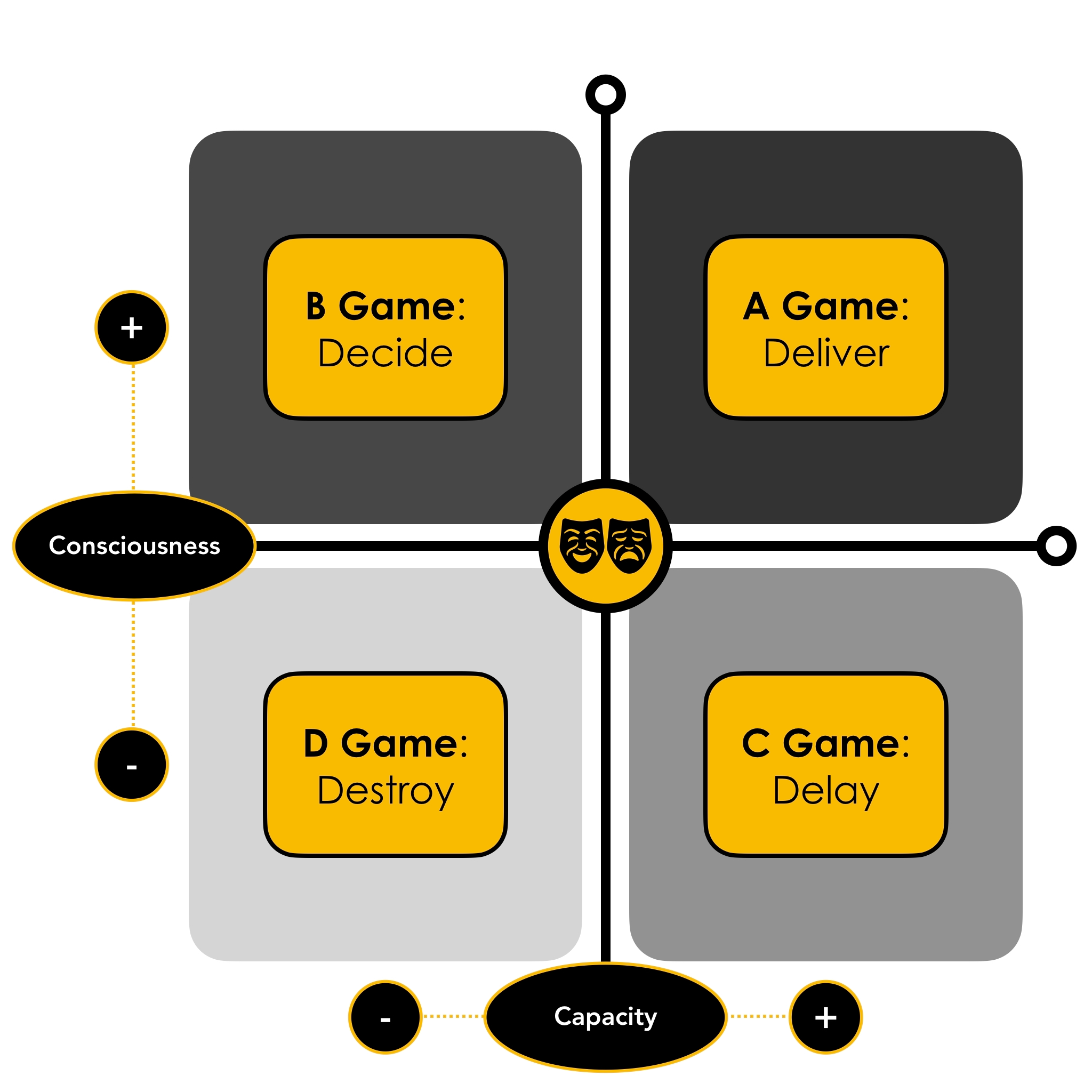
If you're ‘happy and you know it’ you're in A Game. While in A Game you can Deliver on most anything because you have the Capacity to be whatever is needed and the Consciousness to know it is needed.
In B Game you're ‘unhappy but you know it’ and because you know it, you retain the ability to Decide how to behave.
C Game is when you 'don't know how happy you could be'. You have unrealized Capacity that is causing you to Delay on meeting the needs of your team.
In D Game you Destroy because you are 'unaware of how unhappy you truly are'. You have no Capacity to deal with things and are not Conscious of that fact so you engage in largely defensive and destructive behaviour. The key to remember with D Game is you never know you're in it, even if everyone around you sees the fallout caused by it.
If you’ve ever seen someone in D Game and thought, “what the heck are they thinking?” You now know that they aren’t thinking, they’re reacting. Just know that others have had this same experience with you while you’ve been unaware of your own misbehaviour.
Competence is a measure of how skilled someone is at their job and how much instruction they require to do it as a result.
Culture refers to the degree to which someone applies their Competence in a manner that respects every other member of the team. Someone can be brilliant at their job, but if the way they do their job makes things difficult for others on the team, this person would be considered to be working against the Culture.
Taken together these two elements create what we refer to as 'Player'.
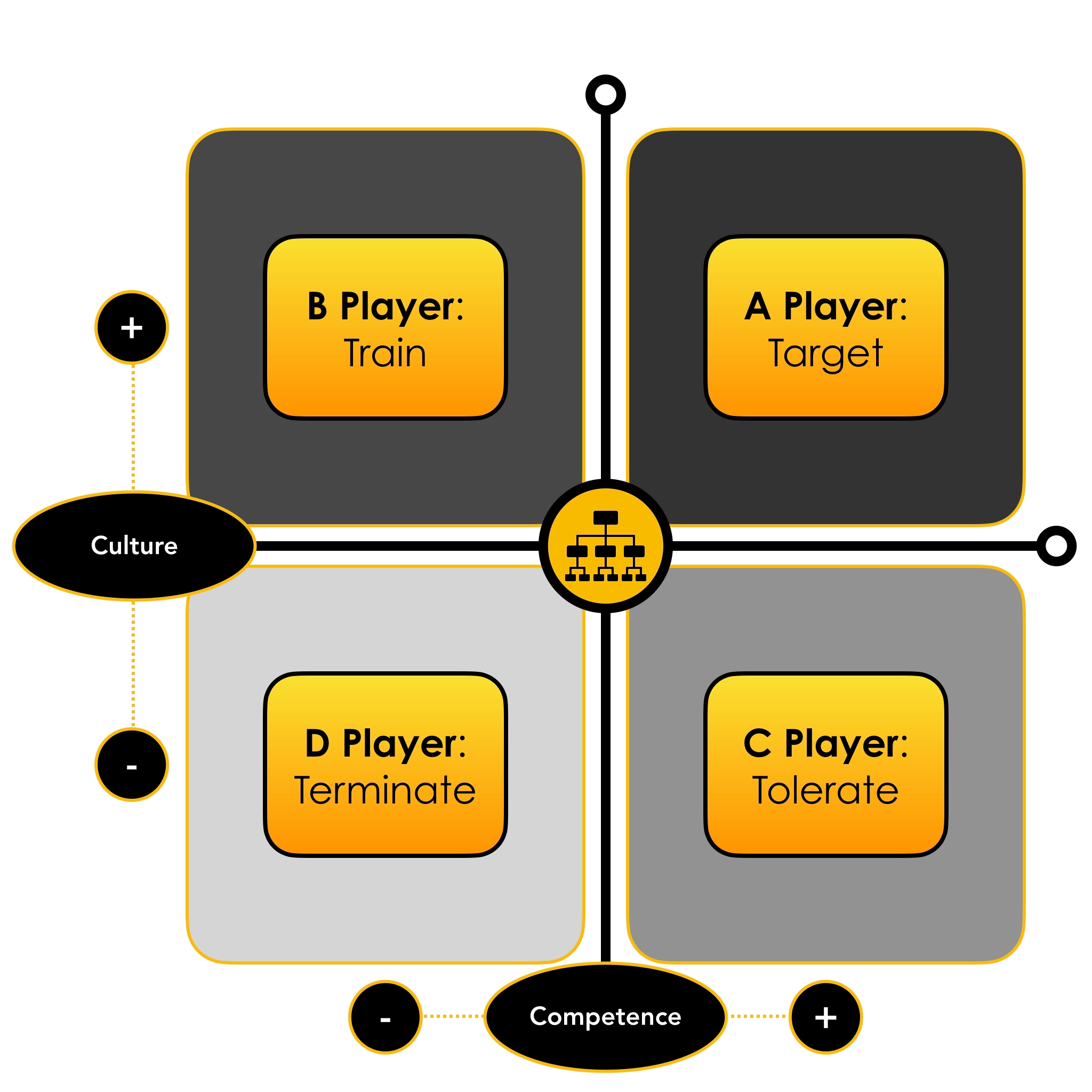
A Players are those whose Competence is being used to further the Culture. Companies would be well-suited to figure out what an A Player is to their organization and Targeting them aggressively whenever possible.
B Players are those whose attitude and efforts support the Culture, yet their Competence is not quite at a place that creates full value, therefore Training them into becoming a future A Player is the smartest thing to do.
D Players lack both Competence and Culture fit and can be safely removed from the team, while C Players are those most leaders and teams end up Tolerating to varying degrees. Of course this level of tolerance is directly correlated to the amount of Competence they are offering, and how difficult it would be to replace that Competence with someone else.
The Engagement Enigma emerges when you are dealing with a disengaged employee. Do you have a C Player (someone who is acting out because they are a poor fit for the Culture) or do you possibly have an A Player who is in C or D Game (someone who is acting out because they're struggling emotionally)? Both individuals will exhibit similar undesired behaviours, however you must be able to tell the difference to avoid serious consequences.
Fail to help an A Player who is in C or D Game and you run the risk of your best people leaving you because they don't feel supported.
Tolerate a C Player for too long and you run the risk of long term damage to the health and performance of your team.
The ONLY way to know the difference is to have a crystal clear picture of what your culture is so that you can measure people against it. Remember that the definition of Culture is the values and beliefs that separate one group of people from another. Therefore having a clear picture of your culture means having a rocksolid set of values that define that culture. A person’s fit within your Culture is the only way to determine if they are an A Player or a C Player which is the only way to determine if their misbehaviour is temporary or if it will reoccur.
You can see how determining your values and measuring how well aligned your people are with them is the only way to properly understand issues of engagement, and what to do about them. The images below help explain this even further.
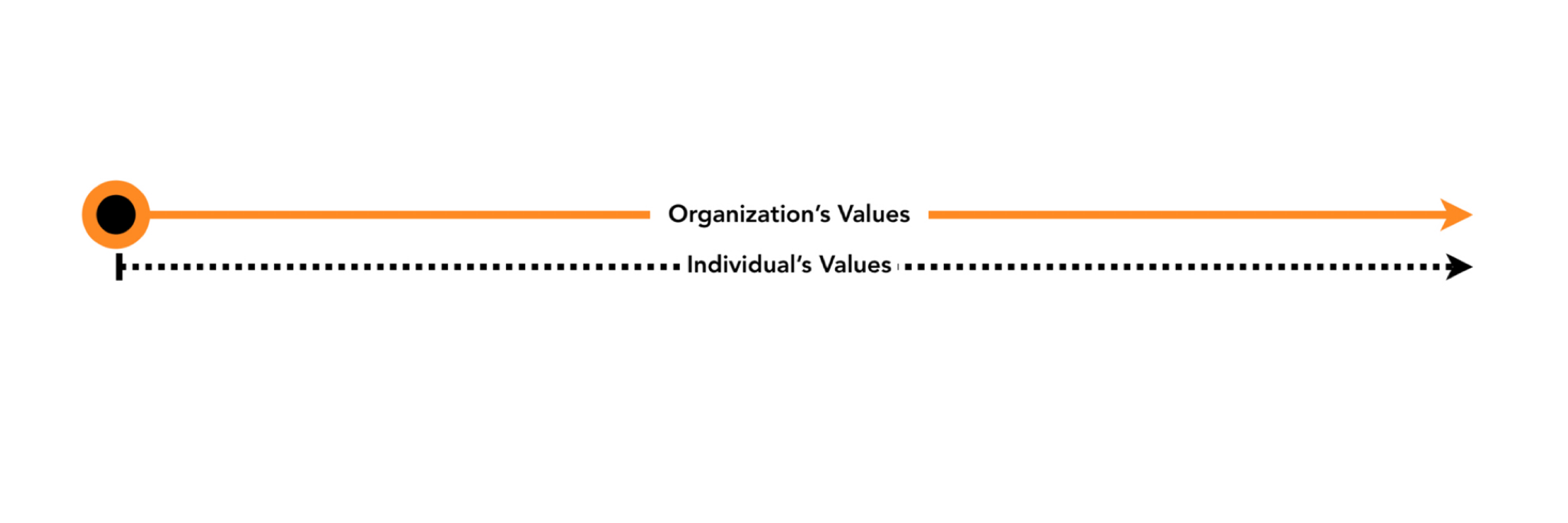
Values set a path forward. They articulate why we do what we do. They also help define the behaviours we need to model to stay on track. When an individual shares the same values as their organization, their efforts are aligned, and they are moving forward together, actively pursuing the same destination.

If an individual is even slightly misaligned with their organization’s values, the further they travel, the wider the gap between them becomes. Over time they end up in completely different places, having spent too much time pushing for completely different things, for completely different reasons.
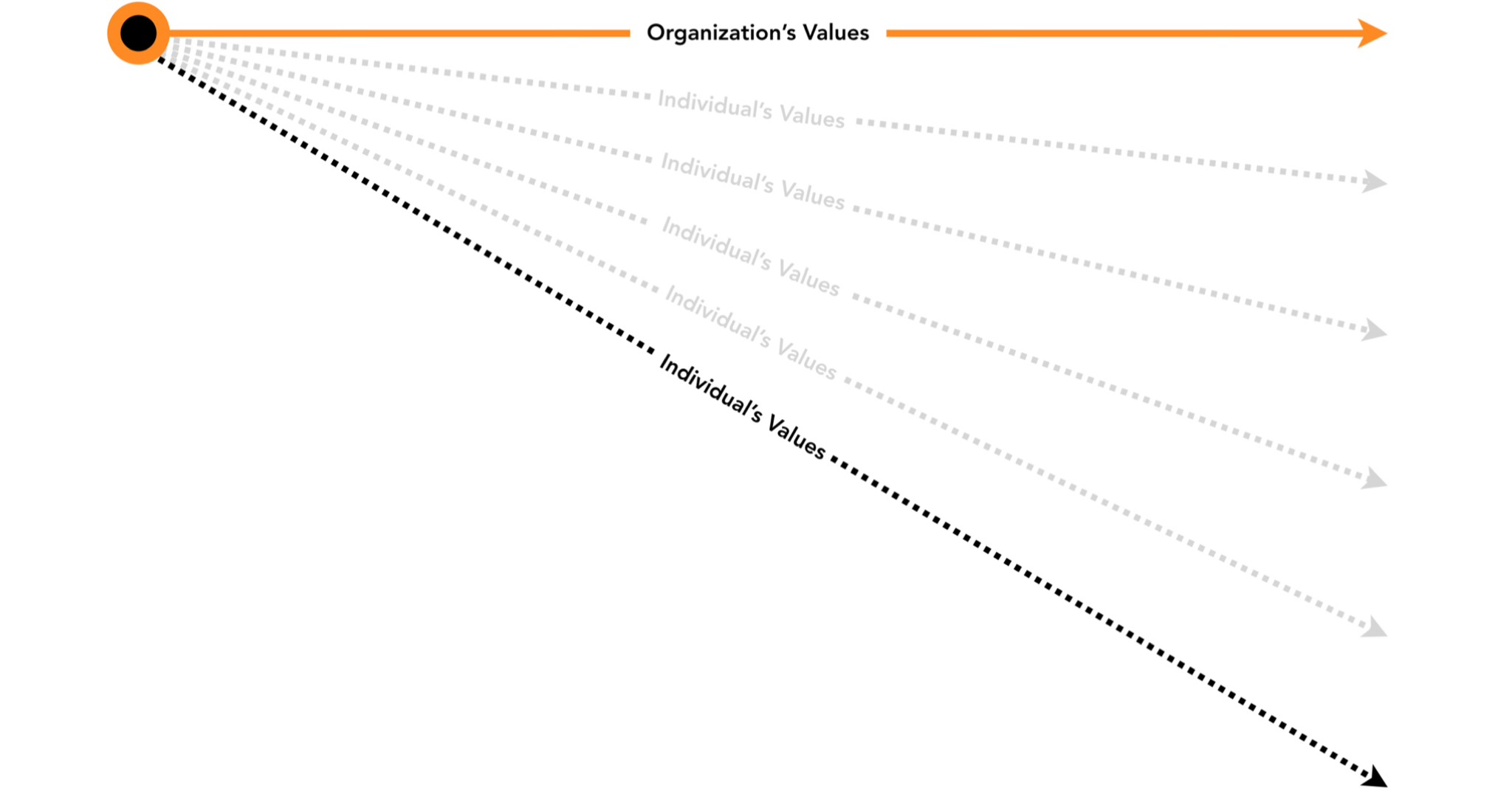
Each degree of misalignment widens the gap. Each day the misalignment is allowed to continue, furthers the distance between where the organization needs to go and where the individual is trying to go. This ultimately leads to turnover, conflict, toxic behaviour and unnecessary surprises that catch leaders off balance.
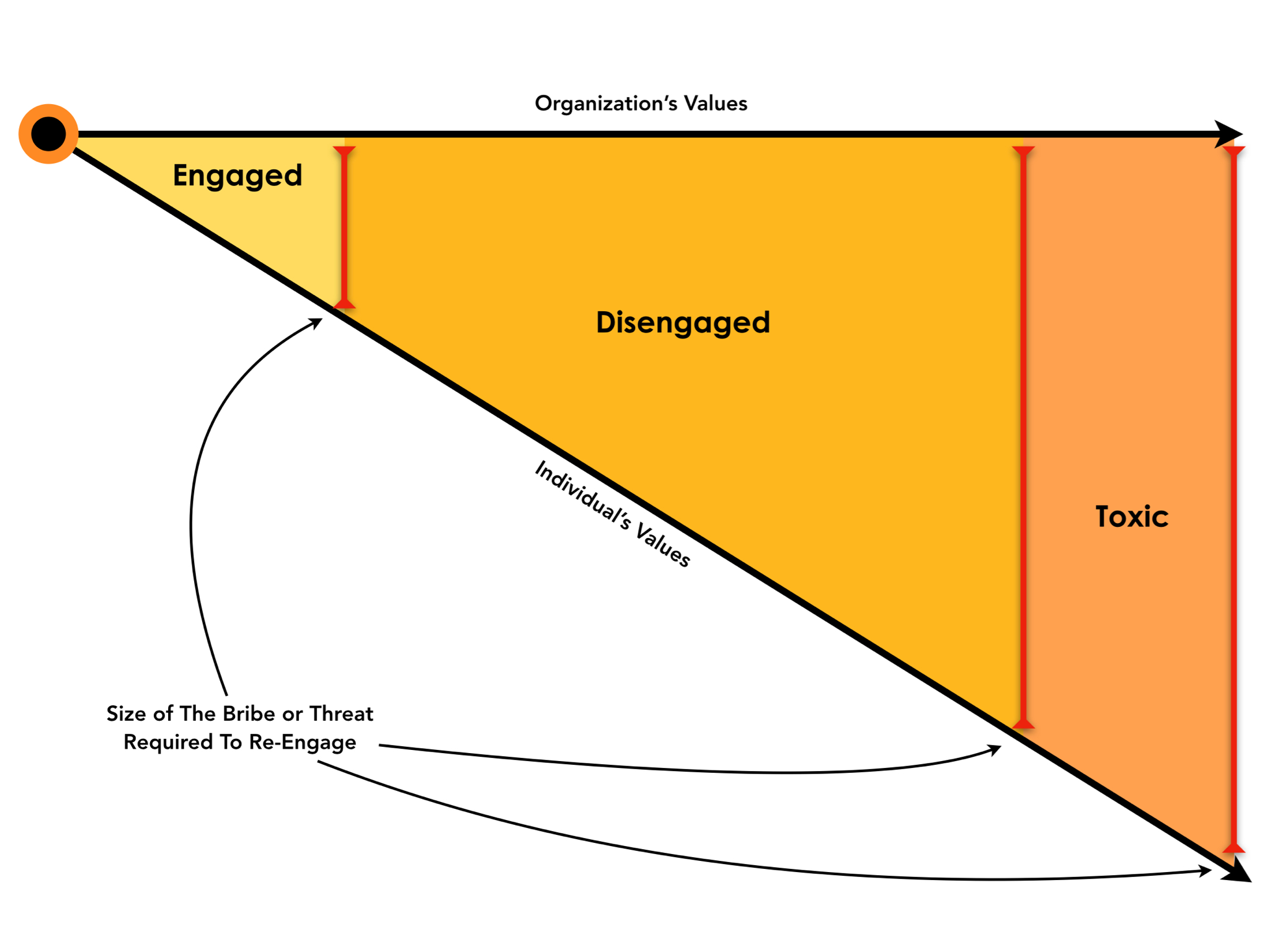
And this is what so many leaders fail to understand when it comes to engagement. Engagement is not a binary concept. A person is not engaged or disengaged. Their level of engagement is derived from the degrees of separation between their values and those of their organization.
Those who are in fulsome alignment are engaged because living the values of the organization feels good to them because these are the values they choose to live their own lives by. They are intrinsically motivated to support the group and are therefore natural advocates for and ambassadors of the culture.
Those who are disengaged will struggle to live the values of the organization to varying degrees as living those values is not intrinsically motivating to them. They can still be productive members of the team, they simply require extrinsic motivation to do so. This extrinsic motivation tends to come in two forms: bribes and threats. They need to know the size of the reward for living the values or the severity of the consequence for failing to do so.
The more degrees of misalignment one has with their organization’s values, the larger the bribes and threats required to engage them. Enough degrees of misalignment and the size of the bribes and threats required gets so large that the company simply cannot deliver on them. Employees at this extreme are often considered toxic. The values they are being asked to embrace as a member of the organization are so far away from their own world view that they feel unsafe as a member of the team. This lack of safety has them unconsciously work against the culture, largely out of defensiveness.
Establishing your values allows you to test alignment. Testing alignment allows you to know how many engaged vs disengaged vs toxic employees you stand to have when you begin to push them to deliver on what the organization needs.
However, alignment is impossible to determine if you can’t quantifiably measure your values. In order to offer true ‘value’ your values must meet two criteria. They must:
A) actually plot a course and define the behaviours required to get you where your organization needs to go and,
B) offer some way to measure people against them.
Most organizations fail in this regard, because most leaders have never been taught how to properly create values. We’re here to help you address that, but first you need to have an honest look at your existing values (or lack thereof) and figure out why they aren’t working hard enough for you.
When we ask people “how’s your culture” they will respond with positive adjectives like ‘fun’ or ‘supportive’ or negative adjectives like ‘tense’ or ‘hostile’. However, when we ask people how effective their culture is, we usually get blank stares.
For some reason, people do not view their cultures in terms of effectiveness. They should. Again your culture represent the values that separate you from all others. Businesses spend countless hours and dollars trying to figure out how to separate themselves from the competition. Forbes, Inc. Magazine and many others will tell you that your culture is the major determinant here. Determining how much more effective your culture is should therefore be one of the first things you look at.
If you want the simplest measure of how effective your culture actually is, all you need to do is ask yourself how far up your organizational chart someone must go before decisions are allowed to be made.
All organizations exist to provide some form of service. Your frontline staff are the closest your organization will ever be to those you serve. Their decisions directly impact your customers and end users. If, in the act of service, they need to run their decisions up through five layers of management to gain permission and input, your customer is the one negatively impacted. That can only happen so many times before you no longer have customers.
The more trust a leader has that their followers will act in the best interest of the organization, the more they will empower those followers to make decisions without immediate oversight. Values alignment across the entire organization ensures that every decision made by every person is being made for the good of the organization. Each person will bring their own subject matter expertise to their role and this will obviously influence a portion of the decision. However, everyone in the organization must make the calls they are making under a shared purpose and this requires a clear, actionable, fully understood set of values to act as guardrails for those decisions. This not only increases the effectiveness of your culture, it reduces the chances of unethical behaviour.
We've spent the better part of 15 years studying the values of both high performing organizations and those who've failed. What we learned was that the difference between success and failure was not tied to whether or not a company had values but rather in the manner in which those values were created. This research resulted in us identifying 3 fatal flaws found in many core values. We share these with you now so that you may gauge your own values, and determine if they are setting you up for success.
Your people cannot decide to live the values of your organization if they cannot remember them. Many of the least successful organizations we encountered had 8, 9 even 10 or more core values. The problem with this, is it stretches the limits of a person's working memory.
There are severe limits to how much can be kept in mind in the moment. The limit is somewhere between 3-5 concepts at once with 4 being the mathematical sweet spot.
If you have more than four Core Values you are significantly reducing your people’s ability to recall them in the moment. If they cannot recall them in a real life situation, they cannot make decisions using them. If you want your values to form the guardrails of decision making, you need to limit the number of them you're asking your people to recall in real-time.
Study the four pictures below:

Now complete the word SO_P.
You most likely said SOAP.
Had we led with these next 5 pictures you would have said SOUP:

This is known as the priming effect and it is a powerful bias we've detected in the creation of many core value statements.
We deliberately chose the pictures in both sets for their subtle differences. Some are bright. Some are dim. Some have words, while others don’t. When faced with a bunch of seemingly random information, our brain will seek the common thread to make sense out of what it's sensing. The common thread in the top 5 pictures is they all have to do with food, in the bottom 5 it’s cleaning. This is how SOAP becomes SOUP.
This is also how a subtle nod from the CEO, or a look of disgust from a close coworker during the meeting to determine a team’s values can have people 'agree' on values they don't actually believe in.
Teams are gathered for a 'brainstorming session' where a bunch of random words are thrown about until a consensus is reached on what the team's values are. The randomness leads to confusion, the confusion leads to the brain seeking patterns and whomever is the most senior, loud or demonstrative in the room, sets the pattern that gets followed. Even if these meetings are professionally facilitated, if the session begins with a blank page and people being asked to generate their own values words, biases have been invited to that meeting.
If your values were not pre-curated and / or professionally facilitated using techniques to override cognitive bias, there is an excellent chance your people are not actually aligned on them despite agreeing on them in the moment. Not only does this mean you may not have the right values, if you are actually using them to make key decisions about your business, you may be taking yourself off track. We've already shown what misalignment can do over time so this is by no means a minor issue.
By far the most damning flaw however is that most companies only have one set of values when in reality they need two. You need values that clearly state who you are, but you also need ones that clearly state who you are not, because these are not always exact opposites of one another.
We explain the law of contrast in detail in our summary of how we build values for our clients here. We will also be covering a detailed example of it below when we offer some advice on what you need to do to build your values the right way.
For now, know that if you only have a single set of core values, without clear definitions of your opposing values, you are accepting a lot of unnecessary and avoidable risk.
The shift from seeking value to serving values can only happen if you can measure the degree of alignment people have with your values. That becomes difficult to do the more of these 3 fatal flaws your values contain.
If you have one or more of these flaws you are not alone. Many companies' values become little more than a poster in their lobby or words their marketing firm said would make them more appealing to potential customers. If you want to prevent the alignment gap above, and the consequences it creates, you need to make a commitment to creating values using a more evidence-based approach. We offer that approach below.
Before we detail how to apply the proper theory to build and test values, it is important to have a basic understanding of some of the most relevant terms of the theory as well as the key takeaways associated with each.
If a person believes they are part of a group, and being part of that group forms a portion of their self-identity, they will become protective both of the group’s interests as well as remaining part of the group. This will have them adjust their behaviour to support their group as supporting the group supports their own self-interests. The more people you have who believe your culture is “that group” the more alignment and therefore engagement you will have.
An in-group is a social group to which a person psychologically identifies as being a member. In-group behaviour is therefore any behaviour that is directly associated with being a member of that group.
Within a company’s culture, these are the behaviours that determine alignment. The highest degree of alignment, and therefore engagement, comes from someone who psychologically identifies with being a member of your culture.
An out-group is a social group with which an individual does not psychologically identify with. Out-group behaviour is therefor any behaviour that goes against retaining membership within that group.
Within a company’s culture, these are the behaviours that determine misalignment. The highest degree of misalignment and therefore behaviour that would be considered toxic to the group, comes from someone who psychologically identifies with a value-set that runs completely counter to that which the group is based.
The psychological definition of threat is a condition that is appraised as danger to one’s self or well-being to a group.
When it comes to values and social identity theory, when the term threat is used it is used in relation to a group. The specific threats we are most interested in here are those that will cause an individual to unconsciously choose between protecting the interests of the group vs their own. Those who are most aligned see no distinction here, protecting the interests of the group IS protecting their own self interest because retaining membership in the group matters deeply to them. Those who are misaligned simply have a “wider gap” between the interests of the group and their own meaning they have an actual choice to make. The wider the gap between their interests and that of the group, the more bribery or coercion is needed to get them to behave in a way that the group needs them to.
Information about reactions to a person’s performance of a task, which is used as a basis for improvement.
We also defined feedback when discussing psychological safety as the manner in which feedback is a major determinant of the level of safety in a group. When it comes to values alignment, feedback constitutes the first two threats that will determine how well aligned someone is with a group. These threats are receiving feedback and providing feedback as both of these situations will cause someone to debate between their own self-interest and that of the group.
When it comes to identity theory we refer to chaos as a sudden, acute lack of clarity brought about by an onslaught of disjointed information or the catastrophic failure of an accepted process.
When it comes to values alignment, a person’s response to chaos is the third threat that will determine how well aligned they are with a group. If this threat causes them to adopt in-group behaviours, their alignment is high. If it cause them to adopt out-group behaviours their alignment is low.
When it comes to identity theory we refer to pressure as a sudden, acute loss of time and / or a sudden, acute increase in delivering on required results.
When it comes to values alignment, a person’s response to pressure is the fourth and final threat that will determine how well aligned they are with a group. If this threat causes them to adopt in-group behaviours, their alignment is high. If it cause them to adopt out-group behaviours their alignment is low.
We used the highly relatable situation of trying to motivate a disengaged employee when describing why values alignment matters. Let’s use an even more relatable situation, trying to determine if someone fits your culture when hiring them, to explain what you need to do in order to make values alignment possible within your organization.
Your culture is the only proprietary element of your business you will ever truly own. Products can be copied. Prices can be beat. Clients can be lured away. The only thing that can’t be replicated are the beliefs that drive who it is you are and why it is you do what you do.
When hiring, it is therefore critical to determine the degree to which a candidate stands to be with you or against you when it matters most. You need to know if they will choose to act in a way that benefits the organization, especially during times when it is inconvenient to do so. This is what it means to assess culture and to do this we turn to the aforementioned Social Identity Theory.
Again, Social Identity Theory refers to the elements of a person’s self-perception that are derived from the groups they are a member of. If you’ve ever taken deep pride in being a fan of a sports team, your fandom is an example of your social identity. Supporting your team feels good which is why you continue to make investments of time, money and emotion, even when the team is mired in a losing season.
The more someone’s self-perception is tied to being a member of the group, the more they will act in a way that puts the group’s interests ahead of their own when tested. If that group happens to be your corporate culture, you can see the power in this. Acting in a way that supports the group when under strain is the exact opposite of becoming toxic.
The behaviours that work for and against the group are the In-Group and Out-Group Behaviours defined above. Within the CultureSmith system, we refer to the values that influence these behaviours as Functional & Frictional Values. The more In-Group Behaviours exhibited by the team, the better that team will function. The more Out-Group Behaviours that are present, the more friction will result.
You first step in creating values alignment is therefore determining the behaviours you need to see from your team as well as the ones you cannot afford to see.
The first step would be to gather your leadership team and determine the various situations where someone’s Personal Identity and Group Identity may come into conflict with one another. To keep things simple (and to ensure validity) we highly recommend that you use the following four situations which you will recognize from the definition section above:
1) when a member of the team receives critical feedback,
2) when a member of the team is expected to provide critical feedback,
3) when a member of the team is expected to respond to chaos,
4) when a member of the team is expect to respond to pressure.
Next you would discuss the behaviours you would want to see from your people when these situations emerge, and you would also discuss the behaviours that you would not wish to see from your people when these situations occur. How do you want people to respond when they receive feedback? What are the potentially harmful ways they could respond? Complete this for all four situations and you will have the In-Group and Out-Group behaviours for your specific culture.
Finally, you would envision some real-life scenarios in your workplace where these situations would emerge and use them as the basis for your interview questions when hiring. If your candidate’s responses are aligned with the In-Group behaviours you’ve identified then you know they stand to be well-aligned with your culture. If however their responses reflect your Out-Group behaviours, there is an excellent chance that they will be uncomfortable in your culture, dramatically increasing the odds that your culture brings out some level of toxicity in them.
One significant recommendation here. You must work to make sure that the words you use to describe both your In-Group and Out-Group behaviours are positive sounding. This can be a bit tricky, but it is very, very important. Remember that we are discussing values which means we are discussing ‘good’ things. Values misalignment occurs when two people have differing views what ‘good’ is. The simplest examples of this are the two things you are often encouraged to never discuss in the workplace: politics and religion. Both describe what a person’s ideas of ‘good’ are which is where the disagreements come from because when arguing, both sides feel as though they are arguing from the side of ‘good’ which is why the argument is rarely resolved.
Your cultural values are no different. You need to know what your version of ‘good’ is and what a competing version of ‘good’ is. If you don’t, the In-Group and Out-Group behaviours you come up with will fail to be an effective benchmark when you actually begin testing people against it.
To show you what we mean about the need for ‘good vs good’ we are going to use a set of our own values from CultureSmith to show you how we incorporate them during an interview process. For this example, the test situation we will use is the need for someone to provide feedback to another.
When it comes to providing feedback we have determined that the value that drives our In-Group behaviours is dependability and the value that drives our Out-Group behaviours is loyalty. Does this mean that loyalty will lead to toxicity in our culture? In a way, yes it does.
Specifically, loyalty will lead to toxicity in our culture if being loyal costs us being dependable. Remember we are only talking about the situation here where someone is expected to provide feedback to another. The In-Group behaviour we expect is that someone will be dependable enough to provide the feedback even if they feel uncomfortable doing so. Someone that values dependability as if it were a religion will have enough of a pull within them to override their internal fear and provide the feedback, especially when doing so is inconvenient, which it often is.
Again, Social Identity Theory states that when triggered, those with strong Social Identity will appear to set their own self-interest aside and act in the best interest of the group because being part of the group forms part of their self-image. Thus, there is no distinction for them between the group's needs and their own because they are one and the same. At CultureSmith, our group needs to be able to depend on feedback at all times with no exceptions.
Conversely, if someone valued loyalty over dependability their loyalty to a person could cause them to be selective in who they provide feedback to. Over time, selective feedback will erode dependability which for us, will create toxicity.
The real benefit to articulating both your In-Group and Out-Group behaviours in positive language however is it makes it impossible for a candidate to ‘game’ the interview questions designed to assess their values.
Remember that lack of contrast is the most critical of the 3 fatal flaws found in most values. Positioning dependability against loyalty allows us to create that contrast which in turn allows us to test people's authentic alignment against our values.
As stated, our culture requires dependability. If we were to interview 100 people and ask them if they felt they were dependable and beyond that, if dependability is a good thing, most if not all would answer yes. There is no way this would tell us however if they truly value dependability and if they would therefore consistently embrace the In-Group behaviour we require.
Suppose we added an Out-Group behaviour for good measure, yet that Out-Group behaviour was negatively worded. Thesaurus.com lists disrespectful as one of a few antonyms to dependability. If we were to ask someone if they felt being dependable was better than being disrespectful, again most if not all would answer yes. However, once again we would have no idea if they really valued dependability to the degree we needed them to because when dependability is pitted against being disrespectful there is a clearly good and a clearly bad choice.
When you are faced with a clearly good and a clearly bad choice, it is the rational part of your brain that influences that decision. Remember however that engagement is the emotional commitment an employee has to their company. If we are going to test engagement and therefore gain an accurate read on the degree to which someone may become toxic, we need to find a way to test emotional as opposed to rational responses in an interview.
Now, if we were to ask the same 100 people who said that dependability is a good thing if loyalty were also a good thing, again most if not all would say yes. Both dependability and loyalty can be almost universally viewed as ‘good’ things. What if however, we pitted loyalty against dependability?
When faced with two ‘universally’ good choices, what you value most becomes the determinant of your behaviour. Our culture requires dependability to be valued more. If we therefore create interview scenarios where someone is forced to choose one of dependability or loyalty as the driver of their behaviour, and they are given no prior knowledge as to which one we deem as better than the other, their values will guide that decision.
Both choices appear to be good meaning there is no easy answer. They will respond the way that feels best to them and we in turn receive an excellent indicator of whether they stand to embrace our In Group or our Out Group behaviour whenever tested. If we replicate this process for each of the remaining triggers (receiving feedback, responding to chaos and responding to pressure) we are left with an excellent indicator of whether or not the candidate will be able to embrace our culture.
This is why conventional interviews fail to assess ‘fit’ and why so many hires go bad. Everyone can see that dependability is a more appropriate choice than disrespectful. Only those who truly value dependability will see it as a superior choice to loyalty. This does not mean someone who chooses loyalty is a ‘bad’ person. They are however, someone who stands to be incredibly uncomfortable within our culture and that lack of comfort increases the risk that their behaviour can become toxic. Loyalty in a vacuum will cause us no harm. Loyalty when dependability is sacrificed to achieve it will.
The mindset shift required to accurately assess culture when hiring, is to realize that it is not enough to know the good and the bad behaviours that will prevent or contribute to toxicity. You must know the theoretically ‘good’ behaviours that will lead to bad outcomes.
You must also shift away from the value you think you are acquiring in the form of the skills on the person's resume and focus instead on their ability to serve the values upon which your culture is built.
Of course not only is the power to change your trajectory in your hands, it's in your "head" and your "heart" too. Human nature complicates the majority of processes and systems designed to help the human in question. Often, this is where we at CultureSmith are invited in by leaders, to help them override their own biases and blindspots to execute on theories whose logic they get, but whose application they do not wish to leave to chance. If you think this may be you, we'd love to hear from you.
Regardless, the complications that people tend to burden themselves with can be broken down into the three buckets of human personality: Values, Behaviours and Emotions.

Values are unique in that they represent the part of your personality that is least likely to change over time. You can learn to become more patient. You can learn to become more self-aware. What tends to remain rigid over time are your beliefs regarding what’s right and wrong and how ‘good’ people should conduct themselves. Those beliefs represent your values.
When two people do not share the same values, they tend to view each other on a spectrum from, “I think that person is wrong” to “I think that person is dangerous”. Now, picture yourself being surrounded by people whom you unconsciously view to be dangerous. How would your behaviour change?
And this is why values alignment is so important. Your people’s values will not magically change. Nor should your company’s values if you wish to stay on course and achieve your stated mission. Go back to our initial story about the car suffering from misalignment. Do you want your car to be able to go the distance, or shake apart the second you need it to go a little bit faster?

Behaviours represent our hard-coded preferences and drive the majority of our actions and reactions.
Building your values in an evidence-based way requires an understanding of behaviours because you need to know which behaviour ties to which specific set of values you have.
For example, values that define how someone responds to feedback can be considered your ‘Yellow Values’ because the ‘Yellow part’ of someone’s behavioural profile dictates how sensitive they are to their Credibility being called into question. So to, giving feedback is tied to Green, responding to chaos is tied to Blue and responding to pressure is tied to Red.
In short, without an understanding of behaviours, you lack the ability to see in real-time the impact your values are having. Without this real-time feedback, it becomes easy for teams to stay from their values causing good companies to go bad.

Now, just because someone is fully aligned with the values of your team, that doesn’t mean they will never have a bad day, nor does it mean their behaviour will be what you want it to be at every turn.
The emotional part of the brain is both the oldest and largest. Emotions must therefore be included in any conversation about human interaction.
Values alignment ensures that when you make someone aware of their misbehaviour, their desire to support the group should lead to a rather quick change in their behaviour. However, you still need the tools to have that conversation with them and they still need the tools to receive that conversation well. Neither are fully possible without both of you working on your emotional intelligence.
As we said, human nature complicates all processes and systems designed to help humans. What you've read here is theory, application requires commitment, empathy and expertise.
We'd love to help you in that regard if you'd like. Learn how our Functional & Frictional ValuesTM will help you uncover the In-Group and Ou-Group behaviours required of your team, and how we demystify both Behaviours and Emotions to allow you to coach any values misalignment using our WorkplaceEQTM program.
If there's one thing we hope you've taken away from this it's that Psychological Safety matters. the good news is, help is a Zoom call away. Book your free, 30min, no-obligation call with one of our experts below, and we will take you through a 7 question assessment that will tell you exactly how safe your team currently is, as well as some free advice on how to get started on improving it.
Those who embark on all 6ShiftsTM To An Uncommon Culture will be successful in turning their company into a place people care about.
They will also wind up with something they need to fiercely protect each and every time they hire.
To learn 'The 7th Shift': how to shift your hiring process from Adding Bodies to Multiplying Engagement, make sure to check-out out HireEQTM page.